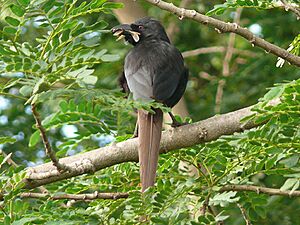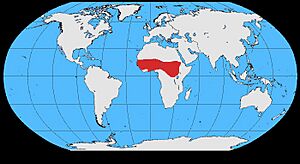Piapiac facts for kids
Quick facts for kids Piapiac |
|
|---|---|
 |
|
| adult with beak full of termites | |
 |
|
| sub-adult (l) and immature (r) Semliki Wildlife Reserve, Uganda |
|
| Conservation status | |
| Scientific classification | |
| Genus: |
Ptilostomus
|
| Species: |
afer
|
 |
|
| Distribution map | |
| Synonyms | |
|
Corvus afer Linnaeus, 1766 |
|
The piapiac (Ptilostomus afer) is a cool African bird. It belongs to the crow family, which includes crows, jays, and magpies. This bird is the only one in its special group, called the genus Ptilostomus. It's actually quite similar to the ground jays found in Central Asia.
Contents
About the Piapiac's Family
The piapiac is part of the crow family. Its scientific name is Ptilostomus afer. This name helps scientists know exactly which bird they are talking about. The word afer means "Africa" in Latin.
In 1837, a naturalist named William Swainson created the special group, or genus, Ptilostomus, just for the piapiac. This means it's a unique bird! Scientists studied the piapiac's DNA in 2005. They found that it is most closely related to the ground jays. These jays live far away in Central Asia.
What Does a Piapiac Look Like?
The piapiac is a bit smaller than a European magpie. It is also a bit slimmer. These birds are about 35 to 42 centimeters (14 to 17 inches) long. They weigh between 121 and 130 grams (4.3 to 4.6 ounces).
Piapiacs are completely black. Their feathers feel very silky. In good light, their feathers have a pretty purplish shine. The base of their tail feathers is often a bit browner. Unlike most birds of its kind, the piapiac has 10 tail feathers instead of 12.
The feathers on its nose point slightly upwards. They completely cover its nostrils. An adult piapiac has a black bill. Young piapiacs have a bill that is partly reddish-pink near the bottom. Their legs and feet are black. Their eyes can be different colors. They are usually violet, purple, or mauve. They often have a bluish-purple ring around the outside.
The piapiac's voice is usually a high-pitched squeak. It can also sound a bit like a jackdaw. When it is angry, it makes a croaking alarm call. Its head bobs up and down when it does this.
Where Do Piapiacs Live?
Piapiacs live in the warm, tropical parts of central Africa. You can find them from Senegal on the west coast. Their home stretches eastwards in a wide band. This band goes all the way to Sudan and southern Ethiopia.
Within this area, piapiacs like open spaces. They enjoy cultivated land with fields and pasture. You can also find them in small towns and villages nearby.
How Piapiacs Find Food
Piapiacs often look for food in groups. These groups can have ten or more birds. They move together on the ground. They eat insects and other small creatures without backbones. Sometimes, they will also eat dead animals. They might be attracted to the insects around the dead animal as much as the meat itself.
They also eat some fruit from trees. The oily fruit of the oil palm is one of their favorites. Piapiacs can run very fast and are quite agile. They also hop when moving slowly. They will catch insects that are stirred up by cattle's feet. Sometimes, they even ride on the backs of cattle! From there, they dart out to catch their prey.
Piapiac Reproduction and Nests
Piapiacs often build their nests in palm trees. However, they can use other places too. They use strips of palm leaves and grass stems. They stick these together with mud. Then, they line the nest with palm fibers. This creates a cup-shaped nest.
Female piapiacs lay three to seven eggs. They usually lay their eggs between March and April. Piapiac eggs are a very pale blue. They can also be greenish-blue. They often have a few brown spots on them.


